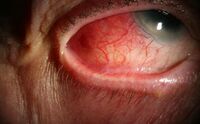Ocular cicatricial pemphigoid
Ocular cicatricial pemphigoid (OCP) is an autoimmune disease characterised by the chronic cicatricial inflammation of the conjunctiva with the occurrence of the blisters and ulcers on the mucous membranes (oral cavity, nose, nasopharynx, larynx, trachea, urethra, vagina and anus), which later also heals with a scar. OCP manifests after the fourth decade of life, and most likely it is a type II hypersensitivity reaction with production of the antibodies against the antigens of the epithelial basal lamina. There are four stages of the disease, the last one ends with keratinisation of the cornea and conjunctiva, the appearance of the symblepharon (formation of the adhesion between the bulbar and palpebral conjunctiva as a result of cicatrisation of the conjunctiva) and ankyloblepharon (adhesion of the edges of the upper eyelid with the lower eyelid).
Etiology[edit | edit source]
Triggering factors are usually eye infections and locally applied medications. The drug "pseudopemphigoid" is developmentally and pathognomic identical to OCP.
Therapy[edit | edit source]
Total immunosuppressive drugs in monotherapy in combination with corticosteroids. Local therapy is focused on trichiasis, transplantation of the mucous membranes (oral cavity, nose) and application of artificial teardrops. Transplantation of the cornea is unsuccessful, abnormalities of the cornea can be healed by suturing the amniotic membrane, a possible temporary solution is to sew a permanent keratoprosthesis.
Links[edit | edit source]
Related articles[edit | edit source]
Bibliography[edit | edit source]
- ROZSÍVAL, Pavel, et al. Oční lékařství. 1. edition. Galén, Karolinum, 2006. 373 pp. ISBN 80-7262-404-0.

